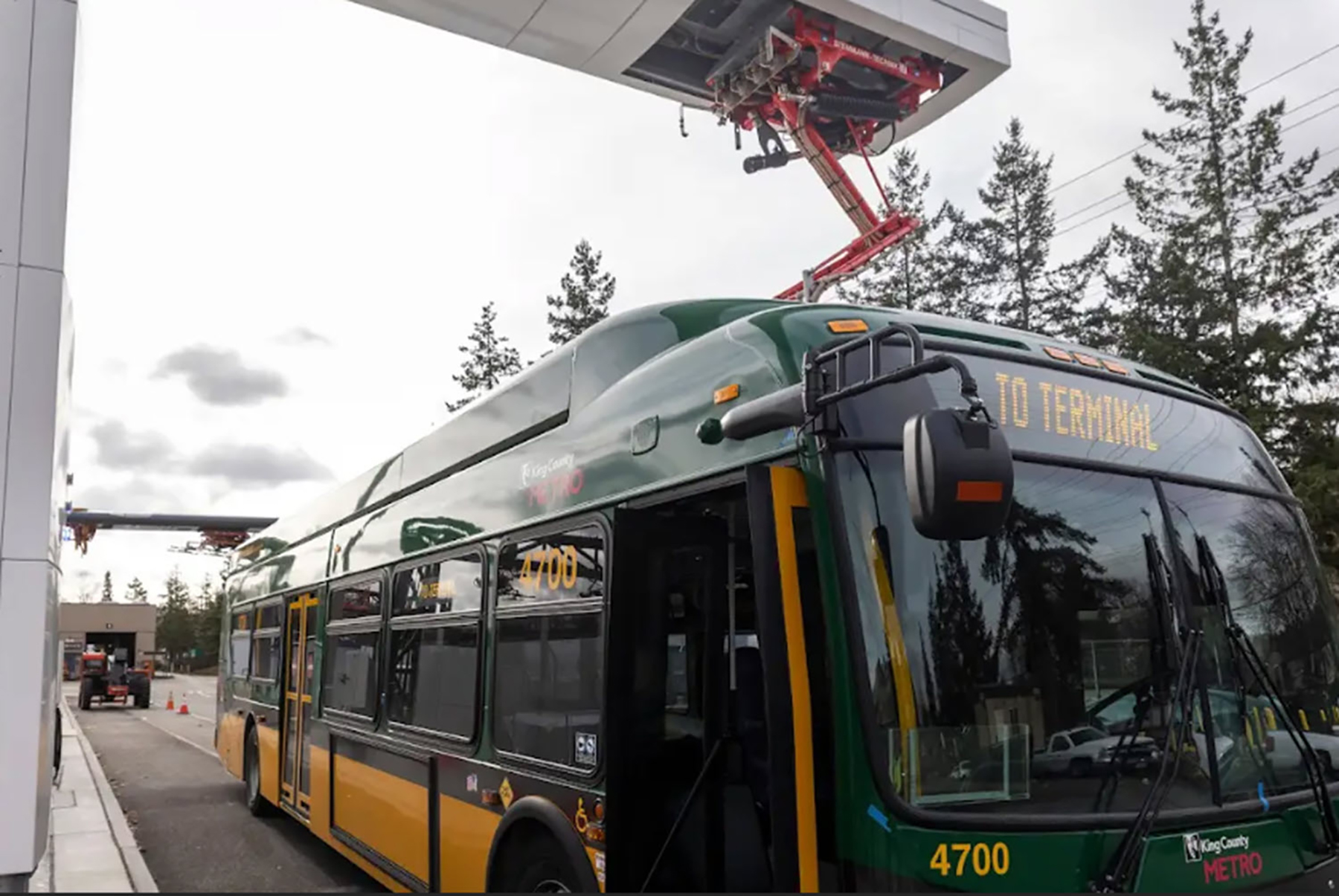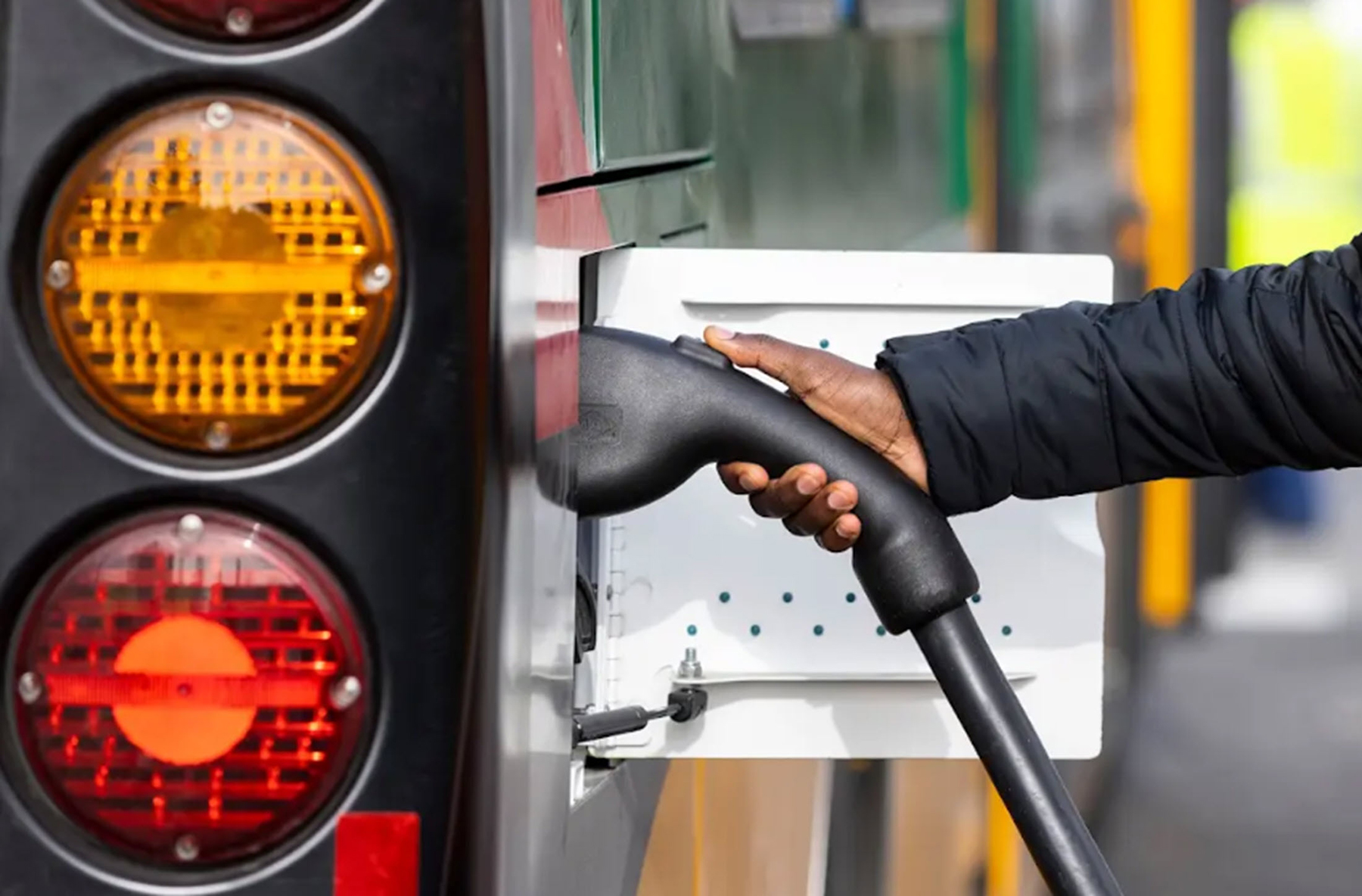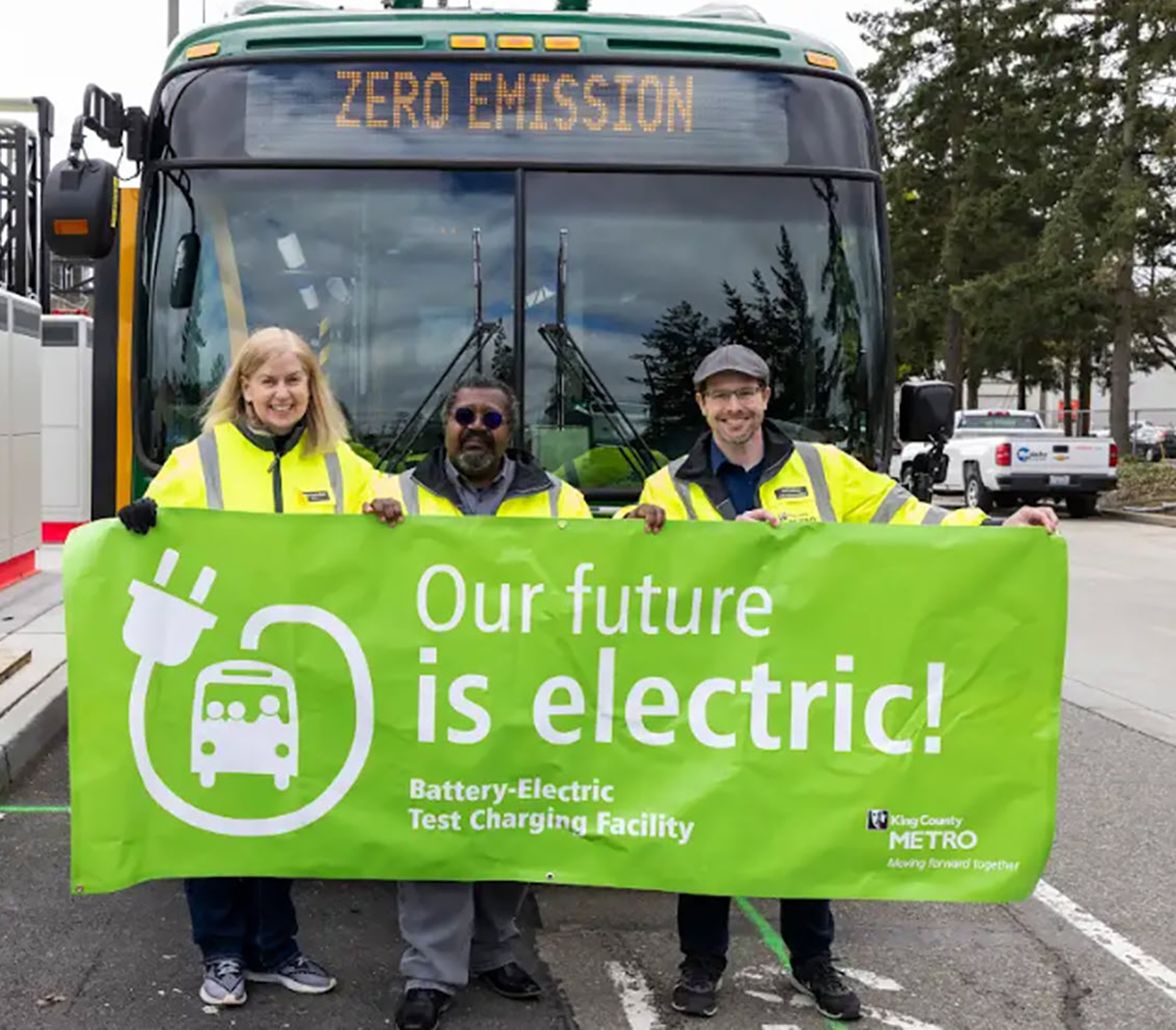By Bart Treece, PTP
Like other modes of transportation, transit buses are going greener. This means conventionally fueled vehicles with their distinctive growl and rumble are being replaced by those powered predominantly by electricity.
Although there have been pilot projects to deploy battery-powered electric buses for revenue service, turning over an entire fleet so that it is electric presents many challenges. These include converting facilities to maintain and operate these vehicles and having the workforce to do so. To do this, it is worth asking what options are available to achieve the vision for zero-emission transit.
King County Metro, the largest transit agency in the Seattle-Puget Sound area and one of the 10 largest in the country, is in the middle of its transition to a zero-emission fleet, with a goal to achieve this by 2035 or earlier. Metro’s seven existing bus bases, which are the heart of its maintenance operations, will need to be renovated to accommodate charging of buses and light-duty vehicles for agency employees to use in the field to support the system.
Traditional procurement methods for a capital project like this include design-build or design-bid-build contracts and place much of the upfront financing and risk on the owner agency. By doing so, however, they potentially miss opportunities to leverage the private industry as an important partner.

Emerging P3
For publicly owned infrastructure, a public-private partnership is a long-term contractual relationship of approximately 35-45 years. It involves a private and public entity and enables multiple forms of project delivery that include private financing.
Employing a P3 can reduce upfront capital construction costs and accelerate development for publicly owned infrastructure projects. In exchange for assuming the risk for project financing and delivery, a private entity will have the opportunity to recover its investment and potentially profit with a revenue stream for an agreed-upon operational period.
To determine whether a P3 is an option for electrifying its base bus facilities in its pursuit of a zero-emissions fleet, Metro worked with the Mobility Innovation Center at the University of Washington. The interdisciplinary center — which is housed with CoMotion, the university’s innovation hub — develops near-term applied research that addresses transportation problems with partners from the public sector, private industry, and nonprofit world to collaborate with academia.
Leading the research effort was Hyun Woo “Chris” Lee, Ph.D., M.ASCE, a PD Koon Endowed Associate Professor in UW’s department of construction management, and Laura Osburn, Ph.D., a senior research scientist in UW’s Center for Education and Research. For six months, this team coordinated closely with King County Metro on its needs and evaluated whether any policy barriers prohibited agencies from entering into P3 agreements. The team also sought to identify industry best practices for project and contract development.
Key findings
Through interviews with industry experts and reviews of contracting documents and existing laws, the research team found a handful of agencies that have used P3 or elements of P3 in transit procurement, offering examples that may be helpful to King County Metro and other public agencies that have similar needs and electrification goals. In November, the Mobility Innovation Center released a report titled Charging Forward: Evaluating Public-Private Partnerships for Electric Bus Base Conversion to Support a Zero-Emission Fleet, summarizing its findings.
Among its key findings, the report notes that P3s can be used to redevelop publicly owned facilities, such as bus bases, for electrification in Washington and other states, including California, Maryland, and Rhode Island. A thorough, nationwide policy evaluation of every state’s P3 laws was not conducted for the report. In the states that were reviewed, some do not have laws that explicitly prohibit the use, but there may be others in which legislation would be useful to support the practice.
In addition to financing needs, other considerations for using P3s include the questions of who should own the energy storage, charging, and management technologies and who should employ the workforce to operate and maintain them. Another consideration entails the possible use of the infrastructure-as-a-service model, in which a public agency pays a private entity to install and operate these systems for a specified period.
With increased demands for utility providers to upgrade transmission line capacity and operational resiliency, bus base conversions may likely require the development and management of on-site microgrids to deliver the electricity needed in the required time frame.
Engagement with internal stakeholders, represented labor, and external partners helps define needs, desired outcomes, and support ahead of advertising and executing P3 agreements.

The spectrum of P3 and its use in practice
A P3 is not an all-or-nothing deal. Rather, various elements can be used for each project. When determining the appropriate delivery method for a project, a public agency should consider several aspects, including the use of a P3. The research team developed a screening tool to guide agencies through the evaluation process.
The first step is to identify the source of project financing, followed by the timeline needed for delivery. Is an agency positioned to fund a capital project, or would shifting upfront capital costs to operating costs and essentially spreading payments over a longer period make more sense? These questions set the stage for the additional aspects to consider.
Given the greater electrical demand that bus base facilities will require if electrified, early coordination with the utility provider is essential to understand its capability for transmission line upgrades. Through industry interviews, the research team learned that a utility may not be able to meet an aggressive timeline required by a transit agency.
One potential solution is an on-site microgrid for generation and batteries for on-site storage, both of which also help with operational resiliency in the event of electrical system disruption.
With new technology required for system use, on-site generation, and storage, a public agency would need to decide if it would rather own the equipment and assume the maintenance responsibility to ensure it is performing as needed. Otherwise, entering into an agreement with performance requirements fulfilled by a private firm may have appeal. These requirements could be structured to ensure guaranteed uptimes for power and even electrical rates for fixed time periods, reducing uncertainty for operational expenses.

Workforce concerns
A variety of jobs and talents keep transit moving and provide a much-needed service to the public. With the switch to electric vehicles, new skill sets are needed to operate and manage high-voltage charging systems. These jobs are already in demand and poised to have favorable outlooks for the future.
Each agency would need to evaluate whether a private company is better suited to operate and maintain an electrical system or if these positions should be filled by agency staff. Alternatively, it may be possible to develop a timeframe whereby a private company operates the system while training agency staff to eventually assume responsibility.
Understanding the parameters of existing labor agreements and working with union representatives early can help determine if a P3 is possible for operations and maintenance and how to include these activities in a contract agreement. In general, industry experts believe that operations and maintenance staff from private entities should complement public agency personnel, not displace people in existing positions.

Partnerships and the future of transit
Above all for a P3 to work, it needs to hold financial promise to make the private side of this appealing and a worthwhile investment. A private entity would be taking on risk and would need to evaluate the long-term benefit for the commitment. In the end, a partnership needs to be a good deal for all involved parties.
For King County Metro, this report provides a much-needed resource to understand its options for project delivery. Metro is in the early stages of exploring how a P3 potentially can help provide EV charging.
Although today is an exciting time for transportation electrification, it is important to recognize that partnerships are needed.
Such partnerships could involve new agreements under which electric utilities and public agencies work better together in new ways. At the same time, the partnerships could entail more formal arrangements, such as a P3 that leverages the talent and expertise of the private sector to help transit providers achieve their climate goals and serve the community. Such an outcome would be the ultimate win for all involved.
Bart Treece, PTP, is the director of the Mobility Innovation Center at the University of Washington.
This article was published by Civil Engineering Online.



